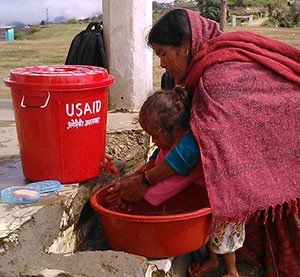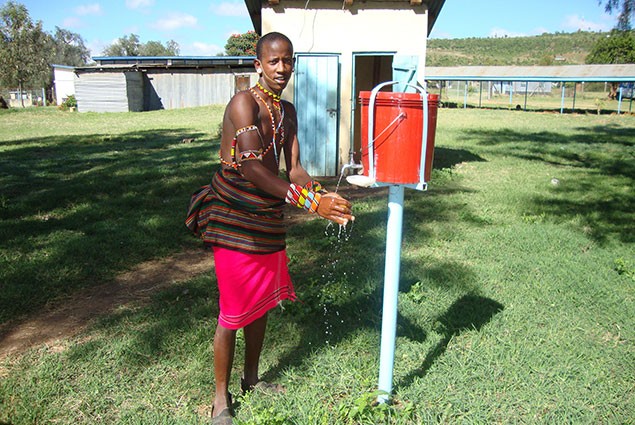- What We Do
- Agriculture and Food Security
- Democracy, Human Rights and Governance
- Economic Growth and Trade
- Education
- Ending Extreme Poverty
- Environment and Global Climate Change
- Gender Equality and Women's Empowerment
- Global Health
- Water and Sanitation
- Working in Crises and Conflict
- U.S. Global Development Lab
- CHILD HEALTH
- IMMUNIZATION
- MATERNAL HEALTH
- NEWBORN HEALTH
- WATER, SANITATION AND HYGIENE

Investing in WASH is one of the most effective and efficient choices we can make for global nutrition, child health, education, and empowerment of women.
Water is an essential component of human health, food security, economic growth, national and regional political security, and environmental sustainability, yet 664 million people, living primarily in sub-Saharan Africa, currently lack access to an improved water supply, and 2.4 billion people have no access to improved sanitation. Recent projections hold that by 2025, two-thirds of the world's population will be living in severe water stress conditions with significant adverse effects on individuals, communities, economies, and ecosystems around the world.
Water and Global Health
The health implications of inadequate access to a safe water supply, sanitation, and hygiene (WASH) negatively affect billions of people around the globe. More than a quarter of the world's population – 2.4 billion people – live without adequate sanitation, and 664 million lack access to safe drinking water.

In 2012, this cluster of risk factors – inadequate drinking water and sanitation and poor hygiene – resulted in an estimated 842,000 deaths, and today accounts for an estimated 58 percent of all diarrheal diseases. Many prove to be fatal, and addressing water sanitation and hygiene could prevent 361,000 deaths in children under five each year. Even when not fatal, chronic diarrhea during early childhood can have long-lasting adverse health effects, as it impedes the uptake of necessary nutrients, thereby hindering the development of children's minds, bodies, and immune systems. Handwashing, improved sanitation, and improvements in household water quality have been shown to significantly reduce the risk of diarrhea.
Women and children are disproportionately affected by inadequate WASH services. In many parts of the developing world, women and girls are responsible for obtaining water for their families and often must spend hours each day seeking out water – not only putting their safety at risk, but also preventing them from playing a more active and productive role in their communities. Women and girls without adequate sanitation services are liable to miss school or work during menstruation or may be put at an increased risk of sexual assault. Handwashing with soap is also a key component of clean and safe birthing practices, which could save up to 40 percent of the 2.8 million infants that die during their first month of life. The expansion and improvement of WASH programming is therefore an important element of the U.S. Agency for International Development's (USAID's) efforts to improve maternal and child survival.
USAID'S Response
Since fiscal year 2014, USAID’s water activities have resulted in more than 4.3 million people with improved access to sanitation facilities. More than 3.4 million cases of diarrhea were treated, and more than 6,000 latrines constructed. USAID managed these and other accomplishments through a wide variety of initiatives in 25 priority countries.
USAID's work in WASH is guided by the 2013–2018 Water and Development Strategy, which aims to save lives and advance development through improvements in water supply, sanitation and hygiene programs and through the sound management and use of water for food security.
In this strategy, USAID lays out a plan to improve health outcomes through the provision of sustainable WASH services and formulates a balanced WASH program as one that incorporates three interdependent pillars:
- Facilitating construction of WASH infrastructure
- Supporting adoption of improved hygiene behaviors
- Creating an enabling policy and institutional environment, including robust financing, monitoring, and the development of local ordinances and regulations to further promote sustainable WASH elements and initiatives
Supporting this overarching Strategic Objective are three intermediate results, used to guide the implementation and planning of USAID's WASH efforts:
Increase first time access, as well as improve existing but inadequate access, to sustainable water supply services. At the end of the Millennium Development Goal period in 2015, it is estimated that 664 million people worldwide will still use unimproved drinking water sources, including unprotected wells and springs and surface water. Nearly half of these people live in sub-Saharan Africa, while one-fifth live in Southern Asia. The vast majority (around 80 percent) of those who do not have access to improved drinking water sources live in rural areas. However, with urban populations expected to swell to nearly 5 billion by 2030, USAID will be faced with new challenges in increasing access for both rural and urban populations. Current USAID initiatives emphasize a shift in focus from infrastructure provision to sustainable water service delivery. This involves decentralization of water-related responsibilities to a local level to increase systems' sustainability and resilience, while also defining and strengthening government and private sector roles in technical and financial support. USAID leverages local partners, builds the capacities of local governments, supports both private and public sector expansion, and develops monitoring systems to promote the sustainability of WASH services.
Expand sustainable access to improved sanitation services. Sanitation access lags far behind that of water and is often left out of programs despite its importance for health. To meet this goal, USAID is refocusing on the sanitation services chain and works to identify and scale up successful existing programs that create demand for private and hygienic sanitation facilities, address issues in the supply chain to make a range of low-cost appropriate options available to our targeted populations, and ensure that excreta is safely managed. This requires working with local partners and governments to implement similar programs on a larger scale. When funds or resources are limited, USAID employs innovative solutions to integrate WASH expansion with other programming initiatives, including nutrition, HIV and AIDS, governance, education, and maternal and child health.
Increase the prevalence of key hygiene behaviors. There is a suite of evidence-based behaviors shown to reduce diarrhea in children under five. These include handwashing with soap, proper disposal of excreta, and improved household water storage, handling, and treatment. Behavior change often requires work done at a local level, and USAID employs diverse approaches to promote key hygiene behaviors in locally-appropriate manners, including mass media communications, community mobilization, social marketing, promotion in schools and health facilities, and interpersonal contact and outreach. Recognizing that the motivators for improved WASH are usually not health-related, USAID facilitates the engagement of the private sector to supply and promote the necessary goods, services, and facilities using messages around privacy, dignity, status, and convenience.

Examples of our Work
USAID health activities place significant emphasis on the behavioral components and household dimensions of WASH. In rural Afghanistan, 89 percent of individuals in 2012 were accustomed to defecating in the open, despite existing projects that involved the construction of latrines and wells: the infrastructure had been introduced but not the corresponding attitudes. As a result, few households had access to a safe water supply, and six Afghan children died every hour from diarrheal dehydration. USAID mobilized communities in rural Afghanistan to seek change and to build the capacity to bring it about. Rather than using subsidies for latrine construction, USAID trained women, religious and community leaders, and teachers in hygiene promotion. The program also trained select community members in community-led total sanitation (CLTS) to ensure ownership and sustainability at the community level. With 42,129 new or renovated latrines for more than 294,900 people, communities developed not only the necessary infrastructure, but also the attitudes and behaviors to put it to effective use.
To promote the systematic and organizational changes necessary for the provision of sustainable WASH, USAID has worked with national governments and other public sector entities. In Mali, USAID provided support to the Ministry of Health in developing guidelines on CLTS, an innovative approach that encourages community ownership of projects to end open defecation. Since the program's inception, 84 communities in Mali have been declared open defecation free. A similar approach in Indonesia likewise emphasized CLTS at the community level, paired with higher-level partnerships to develop sustainable business plans and sound financial management systems. At the end of the 5-year program, a variety of WASH initiatives combined to increase safe water access for 295,965 households and improve sanitation for 27,105 people.
Resources
- USAID Water and Development Strategy 2013-2018 [PDF, 1.9MB]
- USAID's WASH and Nutrition: Water and Development Strategy & Multi-Sectoral Nutrition Strategy [PDF, 237K]
- WASHplus.org: Supportive Environments for Healthy Communities
- USAID Water and Sanitation
- USAID Acting on the Call: Ending Preventable Child and Maternal Deaths
- USAID FY 2014 Annual Health Programs Annual Report to Congress
Photo Gallery

A Simple Act Saves Lives
Handwashing with soap is an extremely effective and cost-efficient intervention to prevent pneumonia and diarrhea in children. Newborns are especially susceptible to pathogenic infections, which account for nearly 30 percent of newborn mortality globally. Photo credit: Kate Holt/Jhpiego.

Efficient, Effective, Affordable
A study in Nepal found that birth attendant and maternal handwashing were associated with a 41 percent reduction in newborn mortality. Handwashing with soap also reduces infections in mothers and children during pregnancy and childbirth. Photo credit: Save the Children.

Changing Behaviors, Saving Lives
USAID's flagship Maternal and Child Survival Program (MCSP) promotes four key behaviors to improve maternal, newborn, and child health: treating drinking water for young children, safe disposal of excrement, clean play spaces, and handwashing with soap. Photo credit: Save the Children.

Important Steps toward Ending Preventable Maternal Mortality
By promoting handwashing at these critical times, MCSP aims to provide expectant mothers with a hygienic birthing experience, reduce newborn infections, and improve nutritional outcomes in children under the age of five. Photo credit: Indrani Kashyap/Jhpiego.

Change Begins at Home
The Clean Household Approach works to generate behavior change and demand for household handwashing stations and soap. MCSP incorporates factors such as perceived wealth, convenience, and social status – more influential motivators than health. Photo credit: Kate Holt/Jhpiego.

Everyone Can Lend a Hand
Sustained handwashing behaviors depend on promoting more homes with dedicated handwashing stations and a consistent availability of soap for convenient, routine handwashing. MCSP links households with local markets and partners with local governments. Photo credit: Kate Holt/Jhpiego.

Access Is the Key to Prevention
The Clean Household Approach is helping to maximize household access to and use of handwashing stations and soap to ensure that no child dies of hygiene-related illnesses. Photo credit: Claryce Auma/Jhpiego.

A Global Undertaking
This Global Handwashing Day, remember that only when we reach the most marginalized children and ensure they receive the same preventive care as their peers elsewhere in the world will we end preventable child deaths. Photo credit: Ali Khurshid/Jhpiego.







Comment
Make a general inquiry or suggest an improvement.